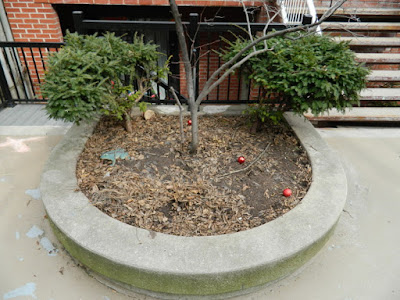We Won't Be Missing Yew(s)
It's almost half way through my winter hiatus or hibernation and while "spring thoughts" shouldn't be in our minds yet, I am being inspired by some gardening books I'm reading now. I haven't posted anything in over a month and wonder why you, dear reader, even stick around this ghost town of a blog. But someone is reading so...onwards and upwards in 2020!
Combing through my 2019 pictures, I realized I never wrote about a few design proposals for a courtyard complex I "maintain" (well, visit in the spring and fall only). I've posted some "before" and "after" pictures of the cleanups I've done for this condo board before. For example, here's a post titled Weeding Raised Beds in a Central Toronto Courtyard: Getting Gritty in Downtown Toronto that shows the beds before and after I work my magic!
There are about a dozen raised beds inside the private courtyard of various sizes and shapes. They all have yews (Taxus sp.), pruned into balls, ovals, alien spacecraft, etc. and most have hostas, that overused workhorse among perennials. That's more or less it. Lots of green.
Automatic irrigation is in place but no one looks after the plants' maintenance (i.e., no weeding or pruning occurs in the summer).
Some of the condo board members expressed an interest to modernize some of the beds as the feeling in the courtyard is definitely circa 1983. They asked me to come up with three drawings for three small beds as a start. In this post (and two future ones), I'll show the existing bed and my rendered sketch showing new perennial possibilities.
Here's "Bed A", for lack of a more scintillating description:
 |
| A New Toronto Pollinator Garden Design Before |
It faces west but will be shaded by early afternoon due to a large tree located nearby. For this and the other raised beds,the clients wanted more plants that offer seasonal interest and encourage more wildlife (pollinators and birds especially) to visit.
My proposal...
 |
| A New Toronto Pollinator Garden Design After |
The yews, I suggest, would be removed but the existing native serviceberry kept. Four types of shade tolerant native species would fill in the small bed:
What do you think of my plant selection?